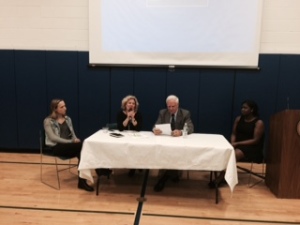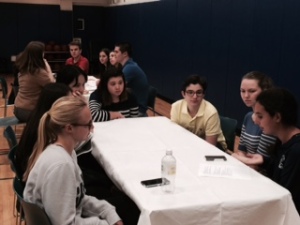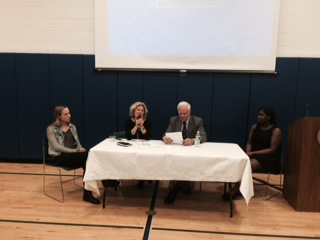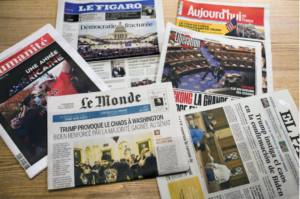
Credit: Christina Saraceno
The conference began with an informal discussion between Merrow and Spanninger on the topic of their experiences in the field of journalism. While Merrow was a reporter in high school, his career began as an English teacher. Ultimately, he came to specialize in education reporting. Spanninger began as a receptionist and worked her way up to her top-level position. Merrow and Spanninger had no shortage of advice for the young journalists. When asked what qualities make a good journalist, Merrow listed what he calls three “rules for being a confident reporter.”
He suggested that reporters use the phrase “Tell me more” to draw out their subjects and to respond to answers by saying “I don’t understand.” Merrow encouraged students to use this phrase “even when you do understand because you find that people talk in their own sort of jargon. You have to be willing to put your ego aside. But it absolutely works. They want to communicate and they want you to understand.” Finally, Merrow’s last piece of advice was to “Shut up – you have to practice that,” Merrow said. “Silence – practice silence. People abhor a vacuum, and they will tell you more.”
The remainder of the conference included presentations from each school where those who occupy the highest ranking positions on the paper share with everyone the format their paper takes (digital, print, or both), their editing process, and even explanations on the meaning and origins of their newspaper’s name. We ended the night with small group discussions of challenges and successes at each paper, which proved to be one of the night’s most fruitful exercises. Among the topics that the students touched on were issues with meeting deadlines, increasing readership, training freshmen reporters, inclusion of middle school students in the paper, and censorship from school administrations. These discussion groups were extremely engaging and helpful in encouraging an inter-publication dialogue to see how some publications might provide solutions to the problems others have been grappling with.

Credit: Christina Saraceno
The Hewitt Times‘ Arts & Culture section editor, Paloma Stafford ’16, reflected on the night by telling us, “I think my favorite part was understanding that today’s generation is not only involved but deeply passionate. The summit was on a weekday nearing AP exams, but the turnout was great. It also felt natural and all student-run — no teachers forcing students to check in. It was a night where a group of teenagers passionate about journalism sat down, listened, and chatted.”
Our Second Annual Journalism Summit was a huge success that has bridged the gaps in knowledge about the inner-workings of peer school publications. Stay tuned for the third installment in our annual series of summits in 2016, and take a look below and at @hewitttimes on Twitter for a recap.
Hewitt Times reporter Ria Sawhney ’17 was live Tweeting the event from start to finish:
This is @Ria_Sawhney tweeting from the 2nd Hewitt Times summit @hewittschool Stay online to get live updates!
— Hewitt Times (@HewittTimes) May 6, 2015
Student reporter asks @John_Merrow about his work in federal prisons #HewittTimesSummit
— Hewitt Times (@HewittTimes) May 6, 2015
Reporter asks how they find stories; @spam1004 says "the best stories come from people I know" and uncovered not from another news source
— Hewitt Times (@HewittTimes) May 6, 2015
#HewittTimesSummit introducing schools' newspapers and talking about all their features
— Hewitt Times (@HewittTimes) May 6, 2015


Be First to Comment